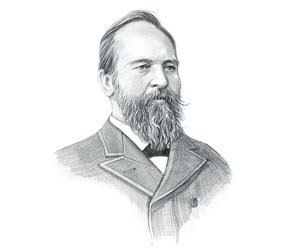|
|
The Garfield Assassination Facts for kids James Garfield (1831 - 1881) was the second of four Presidents of the United States who have been assassinated. The names of the other assassinated presidents were Abraham Lincoln (1809 - 1865), William McKinley (1843 - 1901) and John F. Kennedy (1917 - 1963) When was he shot? The President was shot on July 2, 1881 When did the President die? The President was a strong and determined man who fought hard for his life but he died on September 19, 1881, eleven weeks after being shot Where did the assassination take place? The President was shot at the Baltimore and Potomac Railroad Station What was the name of the assassin? Charles Julius Guiteau (September 8, 1841 – June 30, 1882) Who was Charles J. Guiteau? Charles J. Guiteau was a lawyer and a preacher and had been a supporter of James Garfield. Charles J. Guiteau had been a keen supporter during the Presidential campaign. He had written two speeches which the future president had used during his campaign. Following the election of the president, Charles J. Guiteau insisted that the President should make him ambassador to France. This type of request was not unusual as the infamous Spoils System was in place, a patronage system which allowed the president to appoint party to friends to government offices. The president refused the demands of Charles J. Guiteau who had a grossly inflated ego and a history of mental problems, possibly schizophrenia. Charles J. Guiteau was furious and his bitter reaction led to thoughts of revenge. The twisted and unstable mind of Guiteau rationalized the chain of events as an act of God and believed that the murder of the president was a "Divine command". Guiteau started making his plans to kill the president. He first needed to purchase a gun - he was not used to guns and knew that he would have to undertake some firearm practice. He borrowed $15 to buy the gun. He had a choice between a .44 Webley British Bulldog revolver with a wooden handle or a similar gun but with a silver handle. He was obsessed with becoming famous and chose the gun with the silver inlay because he wanted it to look good in a museum after the event. (During his trial, he said that it was worth the extra dollar). He stalked the president and discovered his travel plans for taking a vacation to Massachusetts by rail from the Baltimore and Potomac Railroad Station on July 2, 1881. Charles J. Guiteau lay in wait and the president accompanied by Secretary of State James G. Blaine arrived at the train station and were making there way through the crowds as the assassin approached them from behind. Charles J. Guiteau raised his gun and fired - the first shot grazed and stunned the President. Guiteau then fired a second shot that lodged deep into his back. Charles J. Guiteau was immediately arrested and taken to jail. The injured president was taken a room upstairs above the depot attended by Dr. Willard Bliss, Surgeon General of the Army and was later transported to the White House. The President did not die until 11 weeks after being shot. Inept doctors probed his wound with unwashed, dirty fingers whilst trying to locate the bullet. The bullet was never found. (The first X-ray machine was not invented until November 8, 1895 by Wilhelm Conrad Rontgen). The president's entire body was riddled with infection (septic poisoning) and he was in agony. The young inventor, Alexander Graham Bell, devised a metal detector to find the bullet, but the device's signal was distorted by the metal bed springs. The bullet was never found and eventually his death was due to blood poisoning. He died on September 19, 1881 at 10:30 p.m. Charles J. Guiteau was sent to trial and was found guilty of murder on January 23, 1882. He was sentenced to death by hanging on June 30, 1882. |
| US American History |
| 1866-1881: Reconstruction Era |
|
|
First Published2016-04-19 | |||
Updated 2018-01-01 | Publisher Siteseen Limited | ||
|

